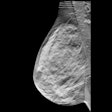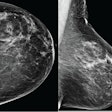
Efforts by the U.S. Food and Drug Administration (FDA) to standardize breast density notification across the U.S. are admirable but could be improved, according to comments submitted to the FDA June 12 by advocacy group DenseBreast-info.org (DB-I).
In a letter to the agency, DB-I Executive Director JoAnn Pushkin and Chief Scientific Advisor Dr. Wendie Berg, PhD, of the University of Pittsburgh School of Medicine and Magee-Womens Hospital of the university's Medical Center (UPMC), lauded the FDA's efforts to improve its Mammography Quality Standards Act (MQSA), including postmammography density reporting.
But they also outlined ways the improvement effort could be further refined, specifically regarding the language for the notifications and how states with existing density notification laws will incorporate the FDA's proposed changes.
"DB-I supports a single national reporting standard that provides all American women with, at least, a base level of information about their breast density, including the potential limitations of their mammogram results," Pushkin and Berg wrote. "DB-I comments ... address both input on the FDA's proposed language content, as well as potential confusion points for states based on their existing density notification requirements."
Clearing confusion
The FDA is proposing two patient density paragraphs, one for women with low breast density and one for those with high density. DB-I suggests the use of specific, bolded phrases to eliminate any confusion for patients.
Rather than the FDA's proposed language -- "Some patients have high breast tissue density ... which makes it harder to find breast cancer on a mammogram. Your breast tissue density is low (high)" -- DB-I suggests, "Breast tissue density can be low or high ... Your breast tissue density is low (high)."
Notification language needs to be completely clear, according to Pushkin.
"Women shouldn't need a decoder ring to figure out what the letter says," she told AuntMinnie.com. "In states with notification legislation that doesn’t require the woman to be told if her breasts are dense, we've seen that women often remain confused about whether they have dense tissue or not, and if they do, what to do next. One woman told me, 'I got the letter, but I don't have dense breasts,' which is not the case -- the reason she got the letter is because she has dense tissue."
How can states incorporate the FDA's proposed notification changes into their existing laws? It's a good question, especially for those that have more stringent requirements than what the FDA is proposing, Berg said.
"There's already confusion about how individual state letters are worded and how they should be modified to include the FDA's changes," she told AuntMinnie.com. "We asked the FDA if states have stronger notification requirements than those it is proposing, do they have to use FDA language? The FDA will have to make clear what, if any, differences are acceptable."
In addition to its suggested inclusion of "unambiguous notifications," DB-I has proposed to the FDA that certain words and phrases be incorporated in all state notification letters:
- High breast density does hide some cancers on a mammogram.
- High breast density does increase the risk of developing breast cancer.
- To increase cancer detection, other imaging tests, in addition to the patient's mammogram, may be appropriate to consider.
"To head off potential confusion and implementation hurdles at the state level when the rule becomes effective, will there be tools, references, or a list of 'accepted' alternative language based on the most commonly used phrases in the existing laws that can be shared?" Pushkin and Berg asked in their comments to the FDA. "Many state laws used the [American College of Radiology] suggested density-reporting language as template. ... It would be helpful if guidance could be provided on which sentences would be 'acceptable' versus those that would not."
Oversold?
The need for density notification in the U.S. is in part because mammography's efficacy has been oversold, Berg said.
"The issue isn't how much of a risk factor density is, but how well we communicate mammography's limitations to our patients," she explained. "We don't want to tell women that everything is fine even when we know that there's a 50% chance we'll miss a cancer in dense tissue on a mammogram. To some extent, we've oversold mammography, and we need to correct for that."
"DB-I supports the FDA in its goal to strengthen the communication of healthcare information in order to allow for more informed decision-making by patients and their health providers," Pushkin and Berg wrote. "As such, we request careful consideration of this response and look forward to patient inform language that is relevant, informative, and unambiguous," they concluded.




















